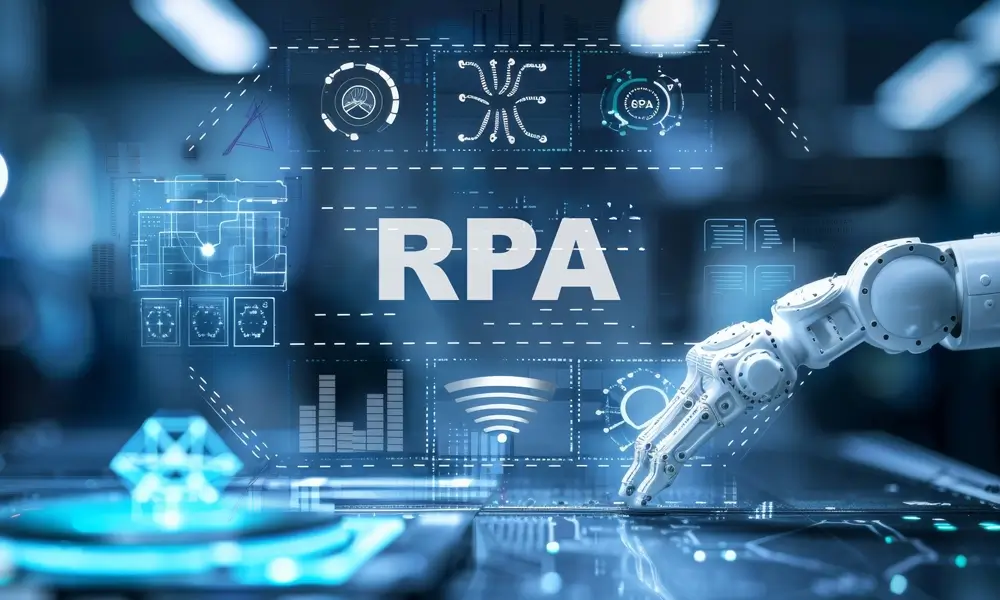Elevate business processes with robotics process automation (RPA)
A robotic process automation (RPA) allows your company to automate repetitive and manual tasks, reducing errors and freeing up time for higher-value work. With RPA, teams gain operational efficiency by accelerating workflows, consolidating data, and reducing rework, raising the level of innovation and competitiveness in the market.

If you want to see practical applications and an implementation step by step, also check out the post Automating processes with RPA for examples and guidance on how to start the automation journey.
What is RPA and how does it work
RPA is based on software capable of automating user interactions with systems and applications, reproducing human activities on interfaces when there is no API integration or when the activity requires interaction with multiple screens. Platforms and bots perform tasks such as reading emails, extracting and validating information, and automatically posting invoices in ERP, freeing up the team for strategic work.
In practice, there are two common approaches: bots that interact with the system's graphical interface and automations that use APIs or direct integrations to exchange data. This combination of tools and technology allows reducing execution time and manual errors, consolidating data between systems, and increasing the security of controls, strengthening compliance and risk management.
Benefits of RPA for companies
- Reduction of rework and manual errors
- Agility in the integration between systems
- Reliability in controls and audits
- Consolidated data in real time
- Improving customer experience
RPA brings concrete gains when applied to high-volume processes and repetitive tasks. For example, when processing invoices, a bot can execute entries and validations automatically, reducing manual errors and rework and freeing up the financial team for strategic analysis.
By integrating RPA platforms and tools, the company gains agility in the exchange of information between systems, either via API or interface automation, which speeds up response time and consolidates data for management reports. In many cases, this reduces operating costs and improves service levels.
From a governance perspective, automation creates consistent audit trails and immutable logs that strengthen internal controls and facilitate regulatory compliance. In critical operations, RPA can monitor access and alert for exceptions, supporting risk management.
In customer service, simple automations eliminate repetitive manual tasks, providing faster responses and freeing agents to handle complex cases. Thus, your company can transform the time saved into greater service capacity and into opportunities to win new customers.
Areas of application of RPA
RPA can be applied in different sectors and functions within the company. Below, practical examples by area, showing the before/after and the typical gains obtained when using bots and integrations with legacy systems or ERPs.
Human Resources (HR)
O RPA in HR simplifies administrative tasks and guarantees more agility in people management processes.
- Payroll and vacation: automation checks calculations, controls vacation balances, and generates reports, reducing inconsistencies.
- recruiting: bots screen resumes and schedule interviews automatically.
- Onboarding: registration of new employees on a regular basis, benefits, and internal systems without manual errors.
- Point and benefit management: automatic verification of records and updates in health plans.
- Engagement and training: enrolling in courses, sending reminders and issuing certificates made by robots.
Finance and Accounting
- Invoice processing: before: manual releases that generate rework; then: bots extract, validate, and release in ERP, reducing errors and accelerating closure.
- Bank reconciliation: automation for comparing statements and entries, with emphasis on exceptional cases forwarded to analysts, reducing reconciliation time.
- Financial closing and report consolidation: software robots gather data from multiple systems and update dashboards, allowing for faster reporting and informed decisions.
- Registration of accounting entries: low-complexity repetitive tasks are performed by RPA tools, freeing up counters for analysis and process improvement.
Purchasing and Supplies
- Accounts payable and receivable automation: automatic processing of invoices, validation of orders and scheduling of payments with integration with the financial system.
- Generating letters of credit: when supported by secure integrations, RPA can accelerate document assembly and checks, reducing the approval cycle.
- Automatic sending of notifications to suppliers: standardized communication about order and payment status, improving relationships and reducing manual inquiries.
Operations and Inventory
- Production and inventory control: bots can feed WMS/ERP systems with counts, trigger replacement orders, and alert for variations, helping to maintain optimal inventory levels.
- Consolidation of information from multiple systems into dashboards: automation facilitates the aggregation of operational data for real-time analysis and decision-making support.
Customer Experience
- Service via chatbots integrated with RPA: chatbots handle basic queries and trigger automations for system queries, providing fast and accurate answers.
- Quick answers to questions and requests: automations perform automatic checks and returns, reducing waiting time and increasing customer satisfaction.
- Reduction of waiting time in support processes: by automating manual tasks and administrative routines, agents focus on solving complex cases, raising the quality of service.
In regulated sectors, such as healthcare, it is essential to plan automations focusing on data security and privacy, ensuring compliance with local requirements. For each area, the implementation of RPA must consider integrations (APIs or interface), bot governance, and success metrics, such as reducing time per process, reducing errors, and increasing service capacity.
RPA combined with Artificial Intelligence
A growing trend is the integration between RPA and artificial intelligence (AI). When combined, RPA and AI form the basis of intelligent automation: RPA performs repetitive tasks and rules, while machine learning and natural language processing techniques enable data analysis, classification, and assisted decision-making.
In practice, this hybrid approach may include OCR to extract information from documents, classification models to separate invoices by type, and bots that forward exceptions for human review. Another example is demand forecasting: analytical models identify historical patterns and robotic process automation automatically triggers replenishment processes, reducing disruptions and optimizing resources.
RPA based only on rules is ideal for predictable processes; automation with AI can handle ambiguous cases and learn over time. This combination does not replace controls or eliminate the need for governance, on the contrary, it requires tool monitoring, model validation, and data management to preserve information security and quality.
In many projects, integrating AI with RPA can increase the assertiveness of automations and broaden the reach of solutions, but it's important to plan proofs of concept, validate results, and measure real gains before scaling.
Learn more about RPA and AI by watching our video content:
RPA as a competitive differential
Companies that adopt the RPA normally achieve greater operational efficiency by reducing the execution time of routine tasks and freeing up professionals for strategic activities. In high-volume operations, for example, it is common to observe a reduction in processing time and a reduction in manual errors, which improves SLAs and accelerates the time-to-market of services and products.
In addition to productivity gains, automation expands the ability to generate insights from data consolidated by bots, strengthening risk management and decision-making. With more agile and reliable processes, your company can reduce operating costs, increase service quality, and often convert efficiency into new customers.
If you want to assess the potential for your organization, count on TATICCA to diagnose maturity in automation and propose a solution that indicates where RPA can bring results.
Count on TATICCA Allinial Global
A Global Allinial TACTICS supports companies from different sectors in the adoption of emerging technologies such as RPA. We work with auditing, accounting, taxes, corporate finance, financial advisory, risk advisory, technology, business consulting and training, offering integrated solutions that combine consulting and practical implementation.
If you want to validate automation opportunities, schedule a process maturity assessment: our consultants analyze critical flows, suggest tools and an implementation roadmap focused on reducing costs, gaining operational efficiency, and safety.
👉 Get in touch: www.taticca.com.br | ✉️ taticca@taticca.com.br
Our professionals have extensive experience and certified methodologies to help your company implement automation with safety and concrete results.





